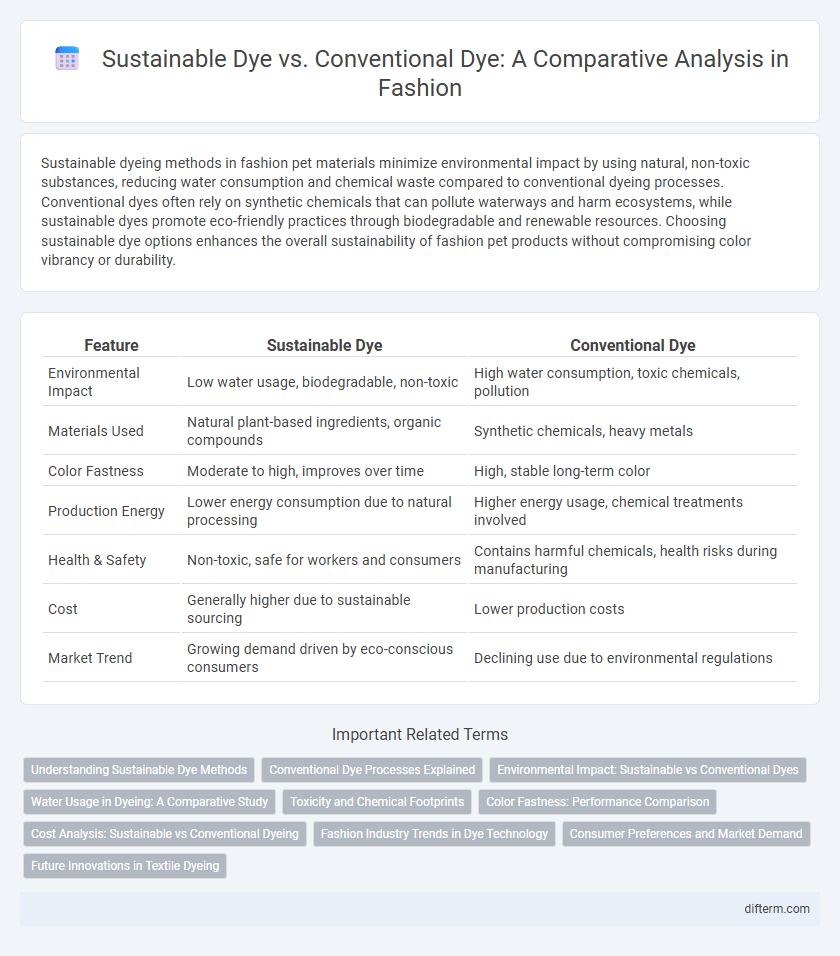Sustainable dyeing methods in fashion pet materials minimize environmental impact by using natural, non-toxic substances, reducing water consumption and chemical waste compared to conventional dyeing processes. Conventional dyes often rely on synthetic chemicals that can pollute waterways and harm ecosystems, while sustainable dyes promote eco-friendly practices through biodegradable and renewable resources. Choosing sustainable dye options enhances the overall sustainability of fashion pet products without compromising color vibrancy or durability.
Table of Comparison
| Feature | Sustainable Dye | Conventional Dye |
|---|---|---|
| Environmental Impact | Low water usage, biodegradable, non-toxic | High water consumption, toxic chemicals, pollution |
| Materials Used | Natural plant-based ingredients, organic compounds | Synthetic chemicals, heavy metals |
| Color Fastness | Moderate to high, improves over time | High, stable long-term color |
| Production Energy | Lower energy consumption due to natural processing | Higher energy usage, chemical treatments involved |
| Health & Safety | Non-toxic, safe for workers and consumers | Contains harmful chemicals, health risks during manufacturing |
| Cost | Generally higher due to sustainable sourcing | Lower production costs |
| Market Trend | Growing demand driven by eco-conscious consumers | Declining use due to environmental regulations |
Understanding Sustainable Dye Methods
Sustainable dye methods minimize environmental impact by using natural, biodegradable materials like plant extracts, reducing water consumption and toxic chemical discharge compared to conventional synthetic dyes. Techniques such as low-water immersion, cold plasma treatment, and biodegradable mordants enhance fabric colorfastness while preserving ecosystem health. Embracing these eco-friendly processes supports circular fashion by promoting resource efficiency and reducing textile industry pollution.
Conventional Dye Processes Explained
Conventional dye processes typically involve synthetic chemical dyes derived from petrochemicals, which contribute to significant water pollution and toxic waste. These methods often require high energy consumption and the use of hazardous substances like heavy metals and salts, impacting both environmental and human health. Despite being cost-effective and widely used, the environmental footprint of conventional dyeing demands urgent innovation toward greener alternatives in the fashion industry.
Environmental Impact: Sustainable vs Conventional Dyes
Sustainable dyes significantly reduce environmental impact by utilizing natural ingredients, minimizing water pollution, and lowering carbon emissions compared to conventional dyes. Conventional dyes often contain toxic chemicals that contaminate waterways and harm aquatic life, contributing to soil degradation and increased greenhouse gas emissions. Adopting sustainable dyes supports eco-friendly textile production by promoting biodegradability and reducing chemical waste in the fashion industry.
Water Usage in Dyeing: A Comparative Study
Sustainable dyeing techniques use up to 90% less water compared to conventional dye methods, significantly reducing environmental impact. Conventional dye processes consume approximately 150 liters of water per kilogram of fabric, whereas sustainable alternatives utilize closed-loop systems and natural dyes that minimize water waste. This drastic reduction in water usage highlights the crucial role of sustainable dyes in conserving freshwater resources in the textile industry.
Toxicity and Chemical Footprints
Sustainable dyes significantly reduce toxicity by using natural, biodegradable ingredients that minimize harmful chemical runoff and lower environmental contamination. Conventional dyes often contain heavy metals and synthetic compounds, leading to increased chemical footprints and adverse effects on aquatic ecosystems and human health. Choosing sustainable dyeing processes helps fashion brands decrease their ecological impact and promote safer production practices.
Color Fastness: Performance Comparison
Sustainable dyes often exhibit improved color fastness due to their natural composition, resisting fading and bleeding more effectively than many conventional synthetic dyes. Conventional dyes, while vibrant and cost-effective, can suffer from quicker color degradation under exposure to sunlight, washing, and abrasion. Enhanced durability of sustainable dyes supports longer garment life and reduces environmental impact from frequent re-dyeing or replacement.
Cost Analysis: Sustainable vs Conventional Dyeing
Sustainable dyeing methods typically incur higher initial costs due to eco-friendly raw materials and energy-efficient processes, but they reduce long-term expenses by minimizing water usage and waste treatment. Conventional dyeing often appears cost-effective upfront, relying on cheaper synthetic chemicals and faster production cycles, though it leads to increased environmental remediation costs and regulatory fines. Investing in sustainable dyes enhances brand value and compliance, ultimately offering better economic viability through reduced environmental impact and consumer demand for green fashion.
Fashion Industry Trends in Dye Technology
Sustainable dye technologies prioritize non-toxic, biodegradable materials and waterless processes, significantly reducing environmental pollution compared to conventional dyeing methods. The fashion industry increasingly adopts natural dyes, digital printing, and low-impact synthetic dyes to meet rising consumer demand for eco-friendly apparel. Innovations such as microbial dyes and enzyme-assisted dyeing are shaping future trends by enhancing color fastness while minimizing chemical waste.
Consumer Preferences and Market Demand
Sustainable dye attracts a growing number of eco-conscious consumers seeking environmentally friendly fashion choices, driving market demand for non-toxic, biodegradable, and low-water-use dye solutions. Conventional dye, often linked to pollution and toxic waste, faces declining preference as awareness of environmental impact influences purchasing decisions. Market trends indicate a shift toward sustainable dye technologies, with brands adopting organic and natural dyes to meet consumer demand for transparency and ethical production.
Future Innovations in Textile Dyeing
Future innovations in textile dyeing emphasize sustainable dyes derived from natural sources and novel bio-based materials that reduce water usage and eliminate toxic chemicals. Advanced technologies such as enzymatic dyeing and digital printing techniques promise higher precision, lower environmental impact, and enhanced fabric compatibility. These developments support circular fashion by enabling biodegradable and less polluting colorants, reshaping industry standards towards eco-friendly production.
Sustainable dye vs Conventional dye Infographic

 difterm.com
difterm.com